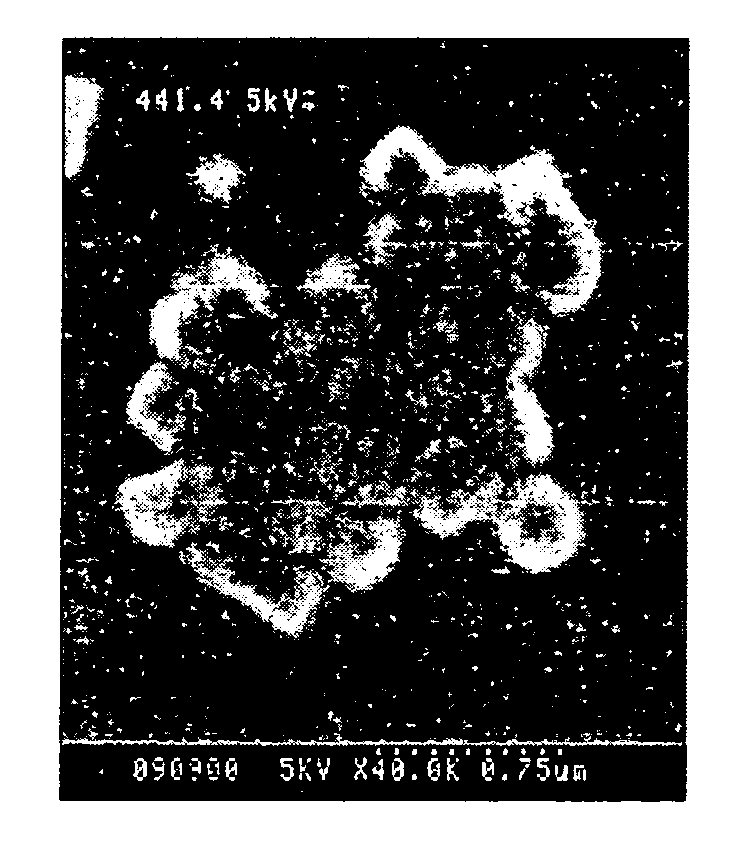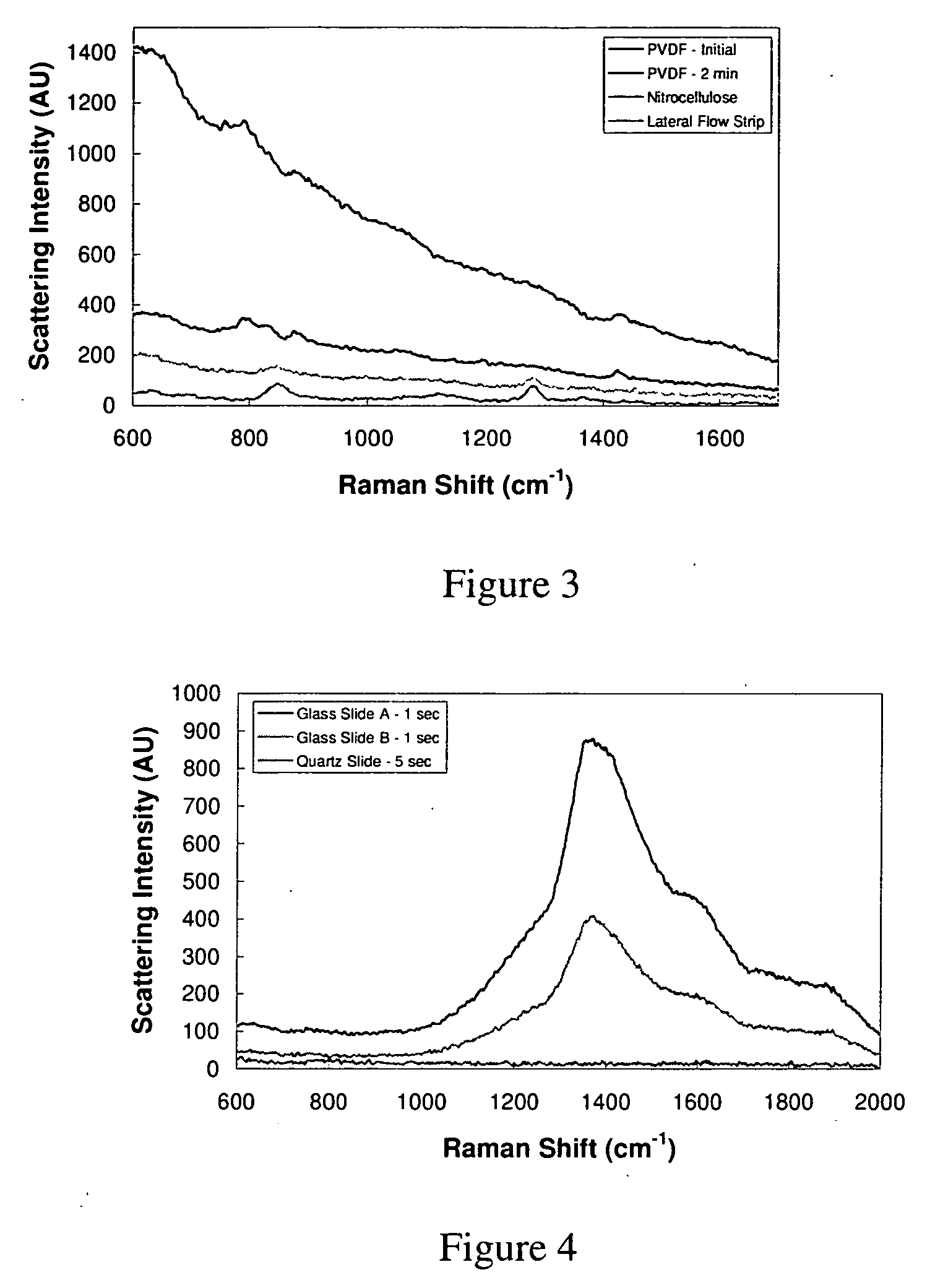Surface enhanced spectrometry-active composite nanoparticles
a composite nanoparticle, enhanced spectrometry technology, applied in the field of submicron particles or, can solve the problems of unsatisfactory biological system, non-targeted cellular delivery approaches, and limited application of organic fluorophores
- Summary
- Abstract
- Description
- Claims
- Application Information
AI Technical Summary
Benefits of technology
Problems solved by technology
Method used
Image
Examples
example 1
[0274] A typical synthesis of ˜45 nm diameter Au colloid using a combination of sodium borohydride, sodium citrate, and hydroxylamine hydrochloride is described. All glassware are washed with aqua regia and rigorously rinsed with 18 MΩ water. The reactions are carried out in a cold room. Solutions of 0.01% (w / w) HAuCl4.3H2O in water, 8% (w / w) sodium citrate dihydrate in 0.01 N NaOH, 10−4% sodium borohydride in 0.01 N NaOH, and 400 mM hydroxylamine hydrochloride in water, are prepared. A mixture of citrate and borohydride solutions is then prepared by combining 1 mL of the sodium citrate solution with 100 μL of the sodium borohydride solution and 500 μL of 0.01 N NaOH. After preparing this mixture 200 μL of the hydroxylamine solution is injected into 100 mL of the HAuCl4 solution in a 250 mL Erlenmeyer flask, and briefly stirred. After 20 minutes the borohydride / citrate mixture is injected into the rapidly stirring solution of HAuCl4 and hydroxylamine. Best results are obtained when ...
example 2
[0275] Preparation of Gold Nanoparticles. Stock solutions of HauCl4.3H2O are prepared at either 1% or 2% concentration (w / v) in H2O. These solutions are filtered through 0.2 μm membranes before being placed in the cold room. The bottles containing the stock solutions are also typically covered in aluminum foil to reduce exposure to light. The following solutions are typically prepared:
[0276] 1. 1.0 L of 0.02% HauCl4 in H2O.
[0277] 2. 5 mL 32% (w / v) sodium citrate dehydrate in 0.01 N NaOH.
[0278] 3. 10 mL 1.6 M hydroxylamine hydrochloride in H2O.
[0279] 4. 10 mL of 4% (w / v) NaBH4 in 1.0 N NaOH which is prepared by dilution of the stock solution.
[0280] All reactions are carried out in a cold room after allowing solutions to reach the temperature of the room. The HauCl4 solution is placed in a 2 L round bottom flask and a glass stirring rod with Teflon paddle is inserted into the flask to provide stirring. 1.0 mL of the hyrdroxylamine solution is added to the flask and stirred. Immed...
example 3
[0281] SERS Spectra of SACNs tagged with both 4-mercaptopyridine (4-MP) and trans-4,4′-bis(pyridyl)ethylene (BPE).
[0282] Materials: Water used for all preparations was 18.2 MΩ, distilled through a Barnstead nanopure system. 3-aminopropyltrimethoxysilane (APTMS), HAuCl4.3H2O, trisodium citrate dihydrate, sodium hydroxide, sodium borohydride, hydroxylamine hydrochloride, trans-1,2-bis(4-pyridyl)ethylene (BPE), 4-mercaptopyridine, sodium silicate, tetraethyl orthosilicate (TEOS), ethyl alcohol, and 2.0 M ammonia in ethanol were obtained from Sigma-Aldrich. BPE was recrystallized before use.
[0283] Colloid preparation: 35-nm colloidal Au was prepared from HAuCl4.3H2O. Aqueous solutions of 4% sodium citrate and 400 mM hydroxylamine hydrochloride were prepared immediately prior to synthesis, as was a solution of 10−2% sodium borohydride in 0.001 N NaOH. A 300 μL aliquot of this borohydride solution was mixed with 500 μL of the citrate and 350 μL of the hydroxylamine and immediately injec...
PUM
| Property | Measurement | Unit |
|---|---|---|
| pore diameter | aaaaa | aaaaa |
| length | aaaaa | aaaaa |
| length | aaaaa | aaaaa |
Abstract
Description
Claims
Application Information
 Login to View More
Login to View More - R&D
- Intellectual Property
- Life Sciences
- Materials
- Tech Scout
- Unparalleled Data Quality
- Higher Quality Content
- 60% Fewer Hallucinations
Browse by: Latest US Patents, China's latest patents, Technical Efficacy Thesaurus, Application Domain, Technology Topic, Popular Technical Reports.
© 2025 PatSnap. All rights reserved.Legal|Privacy policy|Modern Slavery Act Transparency Statement|Sitemap|About US| Contact US: help@patsnap.com



